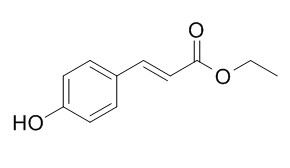p-Coumaric acid ethyl ester
p-Coumaric acid ester has moderate free radical scavenging ability.
Inquire / Order:
manager@chemfaces.com
Technical Inquiries:
service@chemfaces.com
Tel:
+86-27-84237783
Fax:
+86-27-84254680
Address:
1 Building, No. 83, CheCheng Rd., Wuhan Economic and Technological Development Zone, Wuhan, Hubei 430056, PRC
Providing storage is as stated on the product vial and the vial is kept tightly sealed, the product can be stored for up to
24 months(2-8C).
Wherever possible, you should prepare and use solutions on the same day. However, if you need to make up stock solutions in advance, we recommend that you store the solution as aliquots in tightly sealed vials at -20C. Generally, these will be useable for up to two weeks. Before use, and prior to opening the vial we recommend that you allow your product to equilibrate to room temperature for at least 1 hour.
Need more advice on solubility, usage and handling? Please email to: service@chemfaces.com
The packaging of the product may have turned upside down during transportation, resulting in the natural compounds adhering to the neck or cap of the vial. take the vial out of its packaging and gently shake to let the compounds fall to the bottom of the vial. for liquid products, centrifuge at 200-500 RPM to gather the liquid at the bottom of the vial. try to avoid loss or contamination during handling.
Int J Mol Sci.2018, 19(9):E2528
Anticancer Agents Med Chem.2023, 23(10):1204-1210.
Protoplasma.2024, 261(6):1267-1280.
Int J Anal Chem.2017, 2017:1254721
J Nat Med.2017, 71(2):457-462
Front Nutr.2023, 10:1168095.
Korean J. Medicinal Crop Sci.2021, 29(6):425-433
J Appl Biol Chem2023, 66:455−461
Pharmaceuticals (Basel).2024, 17(9):1130.
Phytomedicine.2019, 55:229-237
Related and Featured Products
Free Radicals & Antioxidants, 2011, 1(1):23-7.
P -Coumaric Acid Ester with Potential Antioxidant Activity from the Genus Salvia[Reference:
WebLink]
A phytochemical analysis of the acetone extract of the aerial parts of the plants Salvia splendens and Salvia lanigra yielded a long chain alkyl p-coumaric acid ester; eicosanyl-cis-p-coumarate (1), which has not previously been isolated from Salvia genus, together with two triterpenoids; oleanolic acid (2) and echinocystic acid (3) and two flavonoids; 7-methoxyapigenin (4) and luteolin-7-O-glucoside (5).
METHODS AND RESULTS:
The structures of these compounds were assigned by spectroscopic analysis and comparison with literature data of known compounds.
The antioxidant potential of the p-coumaric acid ester (1) was evaluated, in vitro, by using DPPH for free radical scavenging activity.
CONCLUSIONS:
A moderate free radical scavenging ability was observed.
J Agric Food Chem. 2015 Apr 8;63(13):3402-18.
Sensomics analysis of key bitter compounds in the hard resin of hops (Humulus lupulus L.) and their contribution to the bitter profile of Pilsner-type beer.[Pubmed:
25793563]
Recent brewing trials indicated the occurrence of valuable bitter compounds in the hard resin fraction of hop.
METHODS AND RESULTS:
Aiming at the discovery of these compounds, hop's ε-resin was separated by means of a sensory guided fractionation approach and the key taste molecules were identified by means of UV/vis, LC-TOF-MS, and 1D/2D-NMR studies as well as synthetic experiments. Besides a series of literature known xanthohumol derivatives, multifidol glucosides, flavon-3-on glycosides, and p-coumaric acid esters, a total of 11 bitter tastants are reported for the first time, namely, 1",2"-dihydroxanthohumol F, 4'-hydroxytunicatachalcone, isoxantholupon, 1-methoxy-4-prenylphloroglucinol, dihydrocyclohumulohydrochinone, xanthohumols M, N, and P, and isoxanthohumols M, N, and P, respectively. Human sensory analysis revealed low bitter recognition threshold concentrations ranging from 5 (co-multifidol glucopyranoside) to 198 μmol/L (trans-p-Coumaric acid ethyl ester) depending on their chemical structure. For the first time, LC-MS/MS quantitation of these taste compounds in Pilsner-type beer, followed by taste re-engineering experiments, revealed the additive contribution of iso-α-acids and the identified hard resin components to be truly necessary and sufficient for constructing the authentic bitter percept of beer.
CONCLUSIONS:
Finally, brewing trails using the ε-resin as the only hop source impressively demonstrated the possibility to produce beverages strongly enriched with prenylated hop flavonoids.



